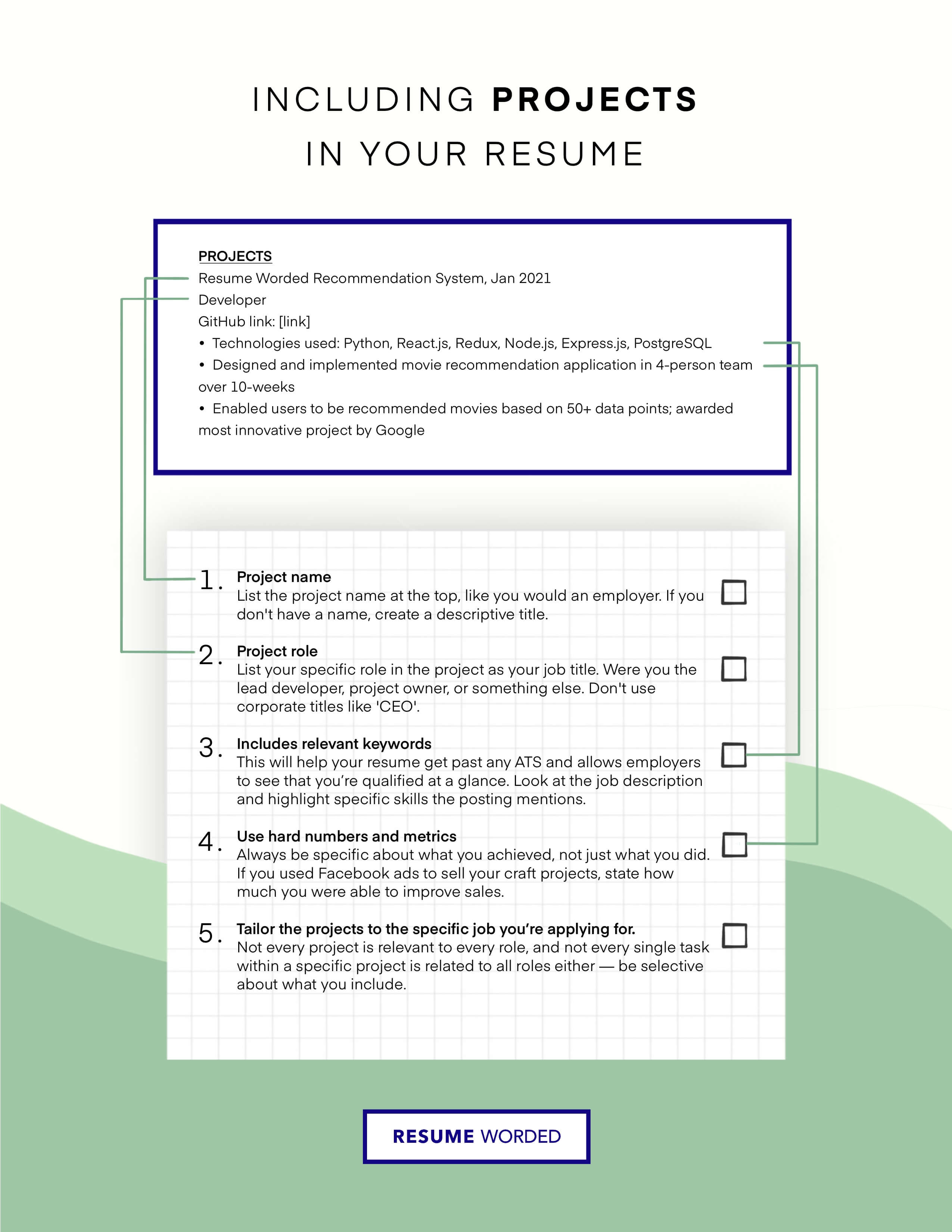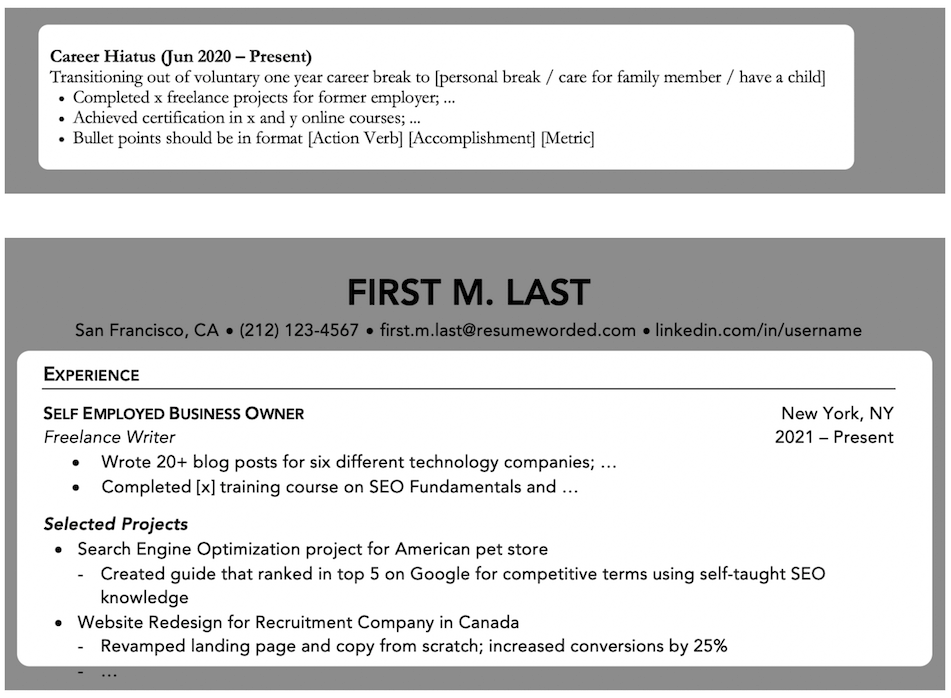You might not have a projects section on your resume — and that’s okay. Including projects on your resume is entirely optional, but it can be a good idea if you’ve completed any personal or educational projects that highlight transferable skills or are relevant to the job you’re applying for.
Should you include projects on a resume?
There is a place for both personal and educational projects on your resume. Projects might be particularly relevant if:
You have a lot of freelance or contract work
If some (or all) of your work has been project-based, your resume should highlight this — not hide it. By using a project-based format for your work experience, you can keep the focus squarely on your accomplishments without cluttering up your resume.
You're a student
Current students or recent graduates can use university projects to highlight your relevant skills in a more practical setting. Educational projects might include projects you completed at university, during further education, or as part of a professional or career change program. It doesn’t include regular coursework, unless it was particularly outstanding (ie. award-winning).
You're changing careers
If most of your paid experience is in a different role or industry, projects can help demonstrate your competence with a more relevant skill set. This is especially true if you’re trying to break into a highly specialized or technical field. For roles involving software development, coding, or data analysis, a few relevant projects may even be more worthy of inclusion on your resume than a lot of work experience in a different industry. If this is your situation, consider dropping some of your older or less relevant work experience in favor of a dedicated projects section that can highlight your hands-on experience with specific technical skills.
I’d recommend uploading your resume to the tool below to check if you’ve listed your projects the right way. It’ll let you know if your projects section highlights relevant work experience, accomplishments and skills.
You lack relevant work experience
Some Applicant Tracking Systems (ATS) or other types of resume screening will automatically reject candidates who lack certain skills or keywords. To get around this, you can use projects as a way to legitimately include skills that are required by the job listing if you have no other way of demonstrating them. Again, this can be particularly important if you’re trying to break into a technical field, so it’s worth taking the time to develop those hands-on skills before you start applying.
If you’re not sure which technical skills are required by the job you’re applying for, use the skills search tool below to find the right ones.
If you've decided to include projects on your resume, keep scrolling for step-by-step guides with templates you can copy and paste.
How to feature projects on your resume
So, you’ve decided to include one or two well-chosen projects on your resume — but how do you format them? Here are a few practical examples you can follow.
In your work experience section
When: If your paid work was project-based, including freelance, consulting, and contract work.
How: List key accomplishments underneath individual projects.
- List your employer, staffing agency, or consulting firm (it's fine to create one if you were freelancing).
- List your job title. If you were self-employed, give yourself a standard job title.
- List the dates of employment.
- Add a short blurb describing the nature of your work.
- Include 3-6 bullet points detailing your most relevant accomplishments, starting with an action verb and include hard numbers and metrics.
- Use a resume checker to score your bullet points and give you personalized feedback.
- Read our tips on how to list contract work and self-employment on a resume.
Template
Here's a template for listing projects in your work experience section:
YOUR NAME CONSULTING SERVICES, Columbus, OH
Independent SEO Consultant (Jun 2017 – Present)
Developed strategic insights for seven medium-large companies ($5M+/year) to improve SEO, web traffic and conversions. Revamped and implemented new websites for four companies.
Selected Projects
Name of project
- 1-3 bullet points in the format [Action Verb] [Accomplishment] [Metric], e.g.
Growth Strategy for Travel Agency
- Spearheaded a major pricing restructure by redirecting focus on consumer willingness to pay instead of product cost; implemented a three-tiered pricing model which increased average sale 35% and margin 12%
This example shows how a project-based resume can emphasize your key skills and achievements.

In a dedicated projects section
When: If you have the space for it on your resume and you have one or more significant projects you want to make a focal point.
How: Think of a projects section like a mini work experience section.
- List the project name at the top, like you would an employer.
- List your specific role in the project as your job title.
- Use bullet points to highlight the hard skills you used. Remember to begin each bullet point with an action verb.
- Use numbers to demonstrate the impact of your role whenever possible.
- Include a link to your online portfolio (if applicable).

Template
Here's a template for formatting a separate projects section:
PROJECTS
Project Name | Developer, Feb 2019
GitHub link: [link]
- Designed the overall architecture of the editor using React.JS, with XYZ integration to allow real-time collaboration
- Set up multiple authentication methods, including Google OAuth, magic link and Shibboleth SSO
This is an example of how a standard project might look on your resume.
This is another example that explicitly demonstrates your skills and expertise. It includes relevant keywords, which will help your resume get past any ATS and allows employers to see that you’re qualified at a glance. It also uses hard numbers to good effect, showcasing not only what you accomplished but also the impact it had on the overall project.
If your projects demonstrate hands-on experience with specific programming languages or other practical skills, use your projects section to link to an online portfolio. Hiring managers in fields like software development, graphic design, and writing will want to see examples of your actual work whenever possible, since that’s the best way to see your skills firsthand and judge whether they’re a good fit.
In your education section
When: If you're a current student or recent graduate without a lot of relevant work experience. You should especially consider including projects in your education section if you completed a specific pre-professional program, like an MBA.
How: Pin your education section to the top of your resume to keep it front and center.
- Title your section 'Education.'
- List your education as normal, including the university you attended, degree attained, and date of graduation (this last one is optional).
- Include a 'Projects' subheading (optional).
- Include 1-2 bullet points briefly outlining what the project was.
- Start with an action verb to describe what you did and use numbers to quantify the results.
- For more tips on how to make your education section stand out to hiring managers, check out our guide on how to list education on your resume.
Template
Here's a template for listing projects in your education section:
EDUCATION
Resume Worded University, San Francisco, CA | May 2010
Master of Business Administration Candidate; Major in Business Analytics
- Built and launched Android app, Resume Worded, in team of 3; gained over 10,000 users in 6 months
This example shows how including projects can explicitly demonstrate your achievements, even if your degree is your only relevant experience in that field.
In an additional section
When: For personal projects, especially if you don’t have the real estate to dedicate to a significant projects section.
How: At the bottom of your resume, or on the side if you prefer a two-column format.
- Title your section 'Additional Projects' or 'Other.'
- If you're using a general 'Other' section including skills, etc. add a 'Projects' subheading.
- List each project briefly in 1-2 lines, including what you did and what the results were.
- (Optional) List the date of completion or duration of the project.
Template
Here's a template for listing projects in an additional section:
ADDITIONAL PROJECTS
- Aggregated, cleansed and combined data from 10+ public data sources to create a Tableau dashboard of inflation rates over the past 10 years (January 2021)
- Another project (optional)
This example demonstrates how you don’t need to dedicate a large amount of space to a project for it to be worthwhile including.
Do’s and don’ts for projects on your resume
Do:
- Use projects to demonstrate hard skills. Technical skills like programming, proficiency with specific software programs, or experience with social media marketing are all appropriate skills you may want to highlight.
- Tailor the projects to the specific job you’re applying for. Not every project is relevant to every role, and not every single task within a specific project is related to all roles either — be selective about what you include.
- Use hard numbers and metrics whenever you can. If you attended a coding boot camp, mention the specific programming languages you learned. If you used Facebook ads to sell your craft projects, state how much you were able to improve sales. Always be specific about what you achieved, not just what you did.
Don’t:
- Don't use projects for soft skills like communication or leadership. These skills are easy for anyone to claim and difficult to quantify, so you’ll want to use more relevant examples of how you’ve demonstrated these in a professional setting.
- Don't include projects in your regular work experience section. No matter how hard you’ve worked on them, they lack the accountability and oversight that paid work experience requires, so don’t try to frame them as something they aren’t.
- Don't include projects just to bulk up your resume. Only include them if they’re truly relevant to the role and will strengthen your candidacy.










